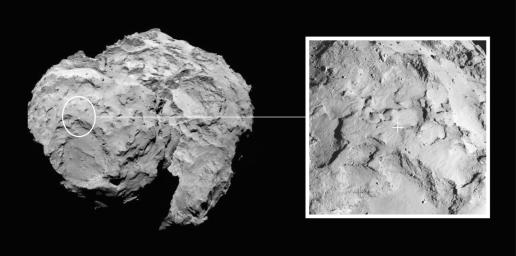
|
Rosetta Lander’s Primary Landing Site
- Click the image above for a larger view
- Full-Res JPEG (3642 x 1806) (497.1 kB)
- Full-Res TIFF (3642 x 1806) (6.6 MB)
Caption:
The location of the primary landing site (Site J) for European Space Agency's Rosetta lander, Philae, is highlighted in this image. Site J is located on the head of comet 67P/Churyumov-Gerasimenko.
The large image of the comet's nucleus was taken on August 16, 2014, from a distance of about 62 miles (100 kilometers).
The inset image to the right shows a close up of Site J. The primary landing site offers the minimum risk to the lander in comparison to the other candidate sites, and is also scientifically interesting, with signs of activity nearby. At Site J, the majority of slopes are less than 30 degrees relative to the local vertical, reducing the chances of Philae toppling over during touchdown. Site J also appears to have relatively few boulders and receives sufficient daily illumination to recharge Philae and continue science operations on the surface beyond the initial battery-powered phase.
The inset image was taken by narrow-angle camera of Rosetta's scientific imaging system on August 20, 2014, from a distance of about 42 miles (67 kilometers). The image scale is 4 feet (1.2 meters) per pixel.
The nucleus of comet 67P/Churyumov-Gerasimenko is about 1.5 miles (4 kilometers) across. The primary landing site was chosen from five candidates during the Landing Site Selection Group meeting held on September 13 and 14, 2014.
Background Info:
The scientific imaging system, OSIRIS, was built by a consortium led by the Max Planck Institute for Solar System Research (Germany) in collaboration with Center of Studies and Activities for Space, University of Padua (Italy), the Astrophysical Laboratory of Marseille (France), the Institute of Astrophysics of Andalusia, CSIC (Spain), the Scientific Support Office of the European Space Agency (Netherlands), the National Institute for Aerospace Technology (Spain), the Technical University of Madrid (Spain), the Department of Physics and Astronomy of Uppsala University (Sweden) and the Institute of Computer and Network Engineering of the TU Braunschweig (Germany). OSIRIS was financially supported by the national funding agencies of Germany (DLR), France (CNES), Italy (ASI), Spain, and Sweden and the ESA Technical Directorate.
Rosetta is an ESA mission with contributions from its member states and NASA. Rosetta's Philae lander is provided by a consortium led by the German Aerospace Center, Cologne; Max Planck Institute for Solar System Research, Gottingen; French National Space Agency, Paris; and the Italian Space Agency, Rome. JPL, a division of the California Institute of Technology, Pasadena, manages the U.S. participation in the Rosetta mission for NASA's Science Mission Directorate in Washington.
For more information on the U.S. instruments aboard Rosetta, visit http://rosetta.jpl.nasa.gov .
More information about Rosetta is available at: http://www.esa.int/rosetta .
Cataloging Keywords:
| Name | Value | Additional Values |
|---|---|---|
| Target | 67P/Churyumov-Gerasimenko | |
| System | Periodic Comets | |
| Target Type | Comet | |
| Mission | Rosetta | |
| Instrument Host | Rosetta Orbiter | Philae Lander |
| Host Type | Orbiter | Lander |
| Instrument | Optical, Spectrocopic and Infrared Remote Imaging System (OSIRIS) | |
| Detector | ||
| Extra Keywords | Grayscale, Infrared | |
| Acquisition Date | ||
| Release Date | 2014-09-15 | |
| Date in Caption | 2014-08-16 | 2014-08-20 |
| Image Credit | Copyright: ESA/Rosetta/MPS for OSIRIS Team MPS/UPD/LAM/IAA/SSO/INTA/UPM/DASP/IDA | |
| Source | photojournal.jpl.nasa.gov/catalog/PIA18809 | |
| Identifier | PIA18809 | |
